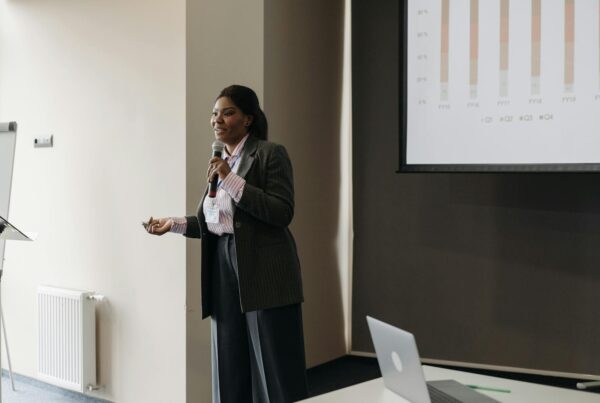Being unable to communicate properly can be a major barrier because, from expressing thoughts and emotions to understanding others, barely any human interaction can be done without communication.
Through our years of interacting with various individuals in various areas of life, we’ve come to find that while many people try to communicate, few are able to do it effectively and concisely.
Our aim in this guide is first to dissect what effective communication comprises and walk you through attaining mastery. So, here’s mastering effective communication: a comprehensive guide.
Mastering Effective Communication
Communication is the process by which information is exchanged from one person to another. It involves verbal and non-verbal cues, including words, gestures, facial expressions, vocal tone, and body language. So if you walked up to someone and said ‘hi’ to them, you have communicated with them. However, this doesn’t mean that the communication you had was effective.
Effective communication goes beyond the mere exchange of words or gestures. It involves active listening, understanding, and responsiveness, regardless of the mode of communication -verbal, written, and non-verbal. To master effective communication, you need to possess a variety of communication skills. These skills will be discussed further on, alongside tips that can help you practice them.
 What Is Effective Communication?
What Is Effective Communication?
Effective communication involves exchanging information, ideas, thoughts, and feelings in a manner that allows the message to be easily understood by the intended audience. This type of communication is focused on establishing a connection between the speaker and the audience. Get your vocal trinity now!
This implies that beyond making sure your message is delivered, you also have to listen actively for verbal and non-verbal responses. For any communication to be effective, it requires:
- Active engagement
- Mutual understanding
- Meaningful exchange of ideas
Although these criteria might seem easy to meet, you would be surprised at how challenging it can be to check the three boxes. However, by learning a few important skills, such as active listening, assertion, and reading non-verbal clues, you can get the hang of it in no time.

What Is Preventing You From Communicating Effectively?
Various factors can serve as barriers to effective communication, preventing you from communicating with and understanding others. To overcome these barriers, you first have to know what they are and how to look out for them. Some common barriers to effective communication include:
Language Barriers
These barriers are caused by differences in language or difficulty in understanding accents. Language barriers mostly occur between individuals who do not share a common linguistic background. For instance, speaking a different language from the person you’re communicating with or having a higher or lower level of proficiency.
Miscommunication can occur as a result of the use of unfamiliar terms, vague language, and technical jargon. It can also occur if the quality of and organization of the information is poor.
Physical Barriers
Physical barriers are caused by factors such as:
- Distance
- Loud noises
- Distractions
- Poor lighting
- Crowded spaces
- Closed doors or thick walls
- Frequent interruption
- Faulty equipment
In cases of virtual communication, it also includes technological glitches, poor internet connectivity, or language translation issues. These factors may disrupt your flow as you communicate. They may also impair audience visibility and audibility, making it more difficult for them to understand what you’re saying.
Emotional Barriers
Your state of mind plays an important role in the way you communicate. When you’re experiencing intense emotions such as anger, fear, or anxiety, it can affect your choice of words and lead to miscommunication. In situations like this, you’re likely to misread your audience and exaggerate or understate your point.
Similarly, your past experiences on a particular subject matter may influence the way you speak about it.
Cultural Barriers
Many cultures have traditions that may forbid people from expressing their opinions on or speaking on certain topics. Family background and upbringing may also play a part in this factor. As a result, you might find it difficult to communicate effectively on certain topics, such as sex, politics, and disabilities.
 Why Is Effective Communication Important?
Why Is Effective Communication Important?
Effective communication is very important in every aspect of human interaction. Without it, we wouldn’t be able to build meaningful relationships, collaborate, or achieve mutual understanding. Here are some reasons why it’s important to communicate effectively:
Promotes Understanding
Communication is mainly about exchanging information, whether in the form of instructions, debates, or educational knowledge. It would thus be quite pointless if the person you’re communicating with doesn’t understand the message you’re trying to pass across.
With effective communication, however, the chances of misunderstandings are reduced. This means you can convey your messages accurately and rest assured that it is understood.
Helps in Building Relationships
Effective communication forms the basis for developing meaningful and lasting relationships. It helps to build trust, empathy, and mutual respect, whether in friendships, romance, or professional partnerships.
Encourages Collaboration
In environments where collaboration is required, such as offices, schools, community projects, and the like, barely any progress can be made without effective communication. It gives room for the exchange of ideas among team members, active listening, and helpful feedback. It also guarantees that everyone’s efforts are coordinated towards the achievement of a joint goal.
Promotes Conflict Resolution
Conflicts are inevitable in any relationship, and more often than not, they are caused by miscommunication. Effective communication allows you to understand the perspectives of others, identify the communication problem, and work towards resolving it before it escalates.
By learning effective communication strategies such as empathy, active listening, and the right use of words, you can find mutually acceptable solutions to settle disputes.
Drives Success in the Workplace
In any business organization, effective communication at various levels is the key to success. Not only is it important for decision-making, planning, and execution, it also helps to inspire trust and motivation among employees, thereby increasing productivity.
Additionally, effective communication with customers, stakeholders, and partners improves brand reputation and customer satisfaction and gives the company a competitive advantage.
What Are the Types of Communication?
Communication can occur in various ways. Mainly, however, there are five methods through which people communicate on a daily basis. These are verbal, non-verbal, written, visual, and listening communication.
 Verbal Communication
Verbal Communication
Verbal communication is the most common and direct form of communication. It involves using spoken words to convey information. This can be carried out in different ways, including
- One-on-one conversations
- Phone calls
- Video conferences
- Meetings
Communicating verbally has to do with more than just the words you say. It encompasses your choice of words and how you string them together to form a message. It also involves your tone of voice and, in cases of physical conversations, your non-verbal communication.
Non-verbal Communication
Non-verbal communication occurs when information is conveyed to others through gestures, facial expressions, body language, posture, eye contact, and other non-verbal cues. While they can be used unintentionally, non-verbal cues are often reflexive. This means that people do them without consciously thinking about it.
For example, a smile can signal friendliness and warmth, while crossed arms may indicate defensiveness or disinterest. You must learn to read non-verbal cues to communicate effectively. Further on, more will be discussed on how you can do this.
Visual Communication
Visual communication involves the use of images, sketches, symbols, charts, graphs, diagrams, and other visual elements to convey information and ideas. This form of communication has grown popular in recent years and mostly occurs via social media, billboards, flyers, magazines, and TV.
Visual communication is mostly used in the following contexts:
- Advertising
- Marketing
- Education
- Presentations
- Games, such as charades
Written Communication
Written communication involves using written words to convey information. This kind of communication can come in various forms, including:
- Books
- Letters
- Emails
- Reports
- Memos
- Manuals
- Articles
- Social media content
Written communication has several benefits. It serves as a permanent record of information and gives the reader the chance to go through it at their own pace. However, it may not be as effective as verbal communication if the content is not accurately written.
Listening
The art of listening is not commonly classified as a mode of communication. However, it actually serves as a major way of communicating because to effectively engage with someone, you first have to listen to them. Listening involves receiving and interpreting verbal and non-verbal messages from others, processing the information, and responding appropriately.
Four Effective Communication Skills to Learn
There are certain skills that enable you to communicate more effectively, regardless of where or with whom you are communicating. Here’s a breakdown of four of these skills:
 Skill 1: Listen Actively
Skill 1: Listen Actively
For any communication to be effective, the focus has to be less on talking and more on listening. Oftentimes, however, people focus more on the words coming out of their mouths than on how the other party is receiving them.
It is important to keep in mind that there is a big difference between hearing and active listening. Hearing is the act of picking out the words coming out of someone’s mouth. Listening, however, requires you to pay attention to both verbal and non-verbal cues, such as subtle intonation in the voice, facial expressions, and body language.
This way, you can tell how the person is feeling, even if their words say otherwise. Being an active listener has several advantages.
- It allows you to understand your audience.
- It makes the person feel heard, which encourages them to express themselves more.
- It can relieve stress by making sure everyone is on the same page.
Here are some tips for becoming an active listener:
Pay Full Attention to the Speaker
Active listening begins with focusing your attention on the speaker and the message they are conveying. Thus, you need to get rid of distractions, such as getting lost in thoughts or scrolling through your phone.
Maintain Eye Contact
Establish and maintain eye contact with the person speaking as much as you can. This conveys that you are attentive and interested in what they have to say. It can also help you pick up on any non-verbal signals they may show.

Aside from eye contact, you can also nod occasionally, smile, and assume an open posture that communicates interest.
Avoid Interrupting
No matter how tempting it is, resist the urge to interrupt while the speaker is talking. Allow them to express themselves fully before responding or asking questions. Also, you shouldn’t try to redirect the conversation to make it about you. For instance, saying something like, “That’s not half as bad as what happened to me.”
Keep in mind that you are not listening actively if you’re simply waiting for your turn to talk. Thus, rather than concentrating on forming a response to the person, concentrate on understanding what they’re saying first.
Listen Without Judgment
Many times, people already form opinions without even listening to everything the other person has to say. This could be because you don’t agree with the person’s ideas or you don’t like their personality. However, to understand them fully, you need to suspend judgment and refrain from criticism.
Instead, approach the conversation with an open mind and a willingness to understand the speaker’s perspective.
Skill 2: Control Your Emotions
Effective communication involves controlling your emotions, particularly in challenging or high-pressure situations. When under the influence of your emotions, you are more likely to say or do something that you will later regret. For this reason, you must learn to remain in a calm and relaxed state to prevent miscommunication.
Different situations can make you feel pressured, such as a job interview, meeting your spouse’s family, or defending an academic project. However, by keeping your emotions in check, you can put yourself in the right state of mind to provide appropriate responses to information. Here are some reasons it’s important to control your emotions:
- Emotions can cloud your judgment and make you irrational. By controlling your emotions, you can maintain clarity and express yourself more effectively
- It helps you listen attentively and process information properly
- It prevents conflict
- It builds trust and respect
- It improves your professional image
Here are some tips for staying calm while communicating:
 Identify Your Triggers
Identify Your Triggers
It is important to recognize your emotional triggers, as well as factors that signal that you’re becoming tense. For instance, your breath getting shallow or your fists clenching. By identifying these triggers in advance, you can prepare coping strategies that will prevent you from losing control.
Take a Pause
If you ever feel intense emotions that you can’t control when communicating, pause for a moment to collect your thoughts before proceeding. Use this time to regulate your breathing, calm your mind, and think about an appropriate response.
Use Humor
When things start getting really intense when communicating, throw in some humor to de-escalate the situation. You can do this by cracking a joke or telling a funny story. However, make sure that you use humor appropriately to prevent things from getting even worse.
Skill 3: Understand Non-verbal Signals
Non-verbal communication refers to facial expressions, body language, posture, gestures, tone of voice, eye contact, and other subtle cues that convey meaning and emotions without the use of words. You would agree that sometimes, you’re able to tell how a person feels about a message simply by observing the way they look or react.
However, it’s not just about learning how to read non-verbal communication. To be an effective communicator, you also have to learn how to use non-verbal cues to express yourself. A good example is the use of closed or open body language. Open body language includes putting your arms by your side, maintaining eye contact, or smiling.
Closed body language, on the other hand, includes having your arms and legs crossed, dodging eye contact, rolling your eyes, or hunching your back. Before discussing tips on reading and using non-verbal communication, first take a look at some of its importance. Non-verbal communication:
- Complements verbal communication and promotes understanding
- Allows you to express emotions that may be difficult to articulate verbally
- Provide clues to deception, discomfort, or dishonesty
- Allows you to adjust your behavior and communication style to suit the preferences of others
Tips for Reading Non-verbal Signals
When communicating with someone, you can read their non-verbal signs using the following tips:
- Pay attention to their facial expressions, such as smiles, frowns, raised eyebrows, or squinted eyes
- Observe their posture, gestures, and movements
- Listen to the tone of voice, volume, pitch, pace, or emphasis on certain words or phrases
- Body language varies based on gender, age, religion, culture, and emotional state. Thus, take these factors into account when interpreting non-verbal signals
- Read body signals as a whole rather than individually.
Tips for Using Non-verbal Signals
Non-verbal signals are like a two-way street. As much as you pay attention to what you receive, you also have to pay attention to what you’re giving out. The following tips can help:
- Make sure that your body language and expressions match your words to prevent contradictions
- Adjust your non-verbal cues to fit the person you’re speaking to, as well as the context of the conversation
- As much as you can, avoid making use of negative body language, even when you’re not feeling a positive emotion
Skill 4: Be Assertive
When people hear the word ‘assertive’, they usually think it translates to being demanding, forceful or authoritative. However, when it comes to effective communication, assertiveness refers to expressing your thoughts and emotions openly and honestly while respecting others in the process.
 It involves standing up for yourself and saying what you think confidently without being hostile or aggressive. By being assertive, you can:
It involves standing up for yourself and saying what you think confidently without being hostile or aggressive. By being assertive, you can:
- Establish boundaries and respect that of others
- Build mutual respect
- Build healthy relationships
- Build your self-esteem and confidence
Here are some tips to help you become more assertive in your day-to-day communication:
Use “I” Statements
Make use of assertive language, such as “I” statements, to express your feelings and needs. For example, say “I feel…” or “I would like…” to communicate assertively. This allows you to express yourself without blaming or accusing others.
Work on Your Body Language
Use assertive body language, such as maintaining eye contact, standing or sitting up straight, and remaining calm.
Learn to Say No
No matter how difficult it may be, whenever something does not sit right with you, learn to say no. Declining unwanted requests or information prevents others from taking advantage of you, and builds your confidence. If it helps, you can look for a solution that works for everyone.
Learn Assertive Communication Techniques
Familiarizing yourself with various assertive communication techniques can help. Examples of such techniques include:
- The broken record technique, which involves repeating your message over and over again, regardless of what the other person says
- Fogging, which involves agreeing with any truths that lie in a statement, even if it contains criticism
- Negative assertion, which involves acknowledging your mistakes openly
Related Questions
How Can I Improve My Communication Skills?
To improve your communication skills, you must prioritize active listening to enable you to understand your audience properly. You should also speak as clearly and briefly as possible to make your message easy to understand. Additionally, you should pay attention to your use of nonverbal communication, such as body language, facial expressions, and tone of voice.
Why Can’t I Communicate Effectively?
Your inability to communicate effectively can stem from various factors. These may include poor listening skills, lack of clarity, intense emotions, and language differences. You may also be uncomfortable talking about certain topics or cannot read non-verbal signals. Additionally, distractions, such as noise, can affect how well you communicate.
How Can I Reduce Nervousness When Communicating?
To reduce nervousness and anxiety when communicating, you can practice relaxation techniques, such as deep breathing beforehand. In case of a presentation or public speaking, you can prepare your message ahead of time. This allows you to remain organized and calm. It may also help if you practice regularly and start with low-pressure topics to gradually build confidence.
Conclusion
Mastering effective communication is not something that can be done in a day. It takes lots of time, practice, and patience. Remember that communication is more than just relaying information. It includes listening, understanding, and building a connection with your audience. By learning the four skills discussed above, you can position yourself to become an expert communicator.






